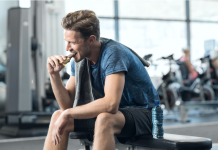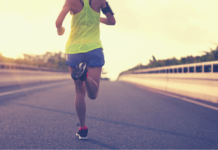How to Get Rid of and Relieve Sore Muscles
1. Warm-Up then Do Dynamic Stretches Pre-Workout
You should always warm-up the muscles and joints you plan to work. Why? Stretching cold muscles is dangerous and counter-productive. That being said, a warm-up should be taken very literal and tackled first, as it will get the blood and oxygen flowing to essentially warm the muscles.
Also dependent on experience level, aim to warm-up for approximately five to 10 minutes, or at least until the muscles feel warmer and heart rate starts to elevate. Common warm-up methods include brisk walking, light jogging, jumping jacks, or riding on a stationary bike.
Following a warm-up, you should then stretch the loosened your muscles to make them more flexible. Do dynamic stretches, or slow and controlled movements, rather than remaining still and holding them. Dynamic stretches may include arm circles, leg raises, hip rotations, and yoga poses.
2. Do Static Stretch and Cool-Down Post-Workout
While the muscles are still warm, continue to do more stretching. But ending a workout, do “static” or holding stretches stretches for up to 30 seconds at a time. These sort of post-workout stretches helps lengthen muscles and improve their flexibility.
And also rather than stopping your workout abruptly and moving onto the next task, take the time to cool down from a workout. A light, 10-minute walk or jog allows heart rate to decline back to normal, along with encouraging blood flow and removing the buildup of lactic acid from your body.
3. Workout with Proper Form
One of the best ways to prevent sore muscles is by working out with proper form during all exercises.
And especially if new to strength training, seek out professional guidance and assistance to avoid injury and show you the ropes. Most gyms offer personal trainers, so at least utilize such services until starting to feel more comfortable and confident navigating through the weight room.
4. Wear Appropriate Workout Gear
While also dependent on the sport or workout itself, always wear the appropriate gear.
For instance, experts at running stores can assist in determining the proper shoe for your foot type, taking into consideration necessary support, cushion, and durability.
5. Eat Post-Workout
While working out is essential to grow muscle, so are the right nutrients. Eating post-workout is required to replenish glycogen stores and put the body in an anabolic state, or the process of building muscle.
As a general rule of thumb, eat a balance of protein and carb within an hour or two within working out, along with considering the following dietary recommendations to optimize muscle recovery:
Protein
Whereas the dietary reference intake (DRI) is 0.8 grams of protein per kilogram (g/kg) of body weight, athletes and people looking to build muscle need approximately 1.2 to 1.7g of protein/kg of body mass, with most nutrition experts agreeing no one needs to consume over 2.0 g/kg.
To get your body weight in kilograms, simply divide your weight in pounds by 2.2. For instance, if a male weighs 180 pounds, he would weigh about 82 kg. And if looking to build muscle, multiply weight in kg by 1.2 to 1.7 (based on current dietary needs), which equates to approximately 98 to 140 grams of protein daily.
Muscles are also only capable of absorbing an approximate 30 grams of protein during each meal, so space out protein throughout the day to achieve daily requirements.
Carbohydrate
Consuming a 3 or 4:1 of carbs to protein following a workout is often recommended for optimal results, as carbs increases insulin levels that helps protein shuttle into the muscles.
Pairing protein with fruit can influence proper muscle fueling thanks to their natural carb content, along with potassium and antioxidants to protect against muscle fatigue and cellular damage.
Fat
Dietary fat complements protein and fat and can be helpful for providing energy to fuel exercise. Fat also assists the body to absorb valuable fat-soluble vitamins, which promotes proper cellular growth and development and ensures a metabolic surplus thanks to its caloric-density.
6. Hydrate
Maintaining hydration is paramount for overall health, including when it comes to muscle recovery.
Water is required to form the structures of protein and glycogen, key components of muscle-building. And if deprived of water, you further place the risk of severe muscle cramping.
Adequate hydration also keeps the joints between bones lubricated, which is extremely important for strength trainers putting great stress on the joints.
7. Consider Other Fluids
While water is always the recommended beverage of choice, other fluids can impact muscle recovery for better (or for worse):
- Sports Drinks
While sports drinks are not always warranted, they can help reduce the risk of muscle cramps, headaches, and nausea on some occasion. As a general rule of thumb, sports nutrition experts recommend athletes to include 30 to 60 grams of carb in the form of sports drinks, solids, and gels if exercising for more than one hour or in hot and humid conditions. Doing so helps delay muscle fatigue and offers extra energy to keep athletes powered during a long exercise duration.
- Chocolate Milk
While regular milk is beneficial and all, a study published in Medicine and Sport Science indicates consuming chocolate milk immediately after exercise and again two hours post-exercise appears to be optimal for exercise recovery and may lessen muscle damage risk.
- Tart Cherry Juice
Tart cherries, rich in antioxidant and anti-inflammatory properties, may have a protective effect to reduce muscle damage and pain during strenuous exercise. Evidence published in the Journal of the International Society of Sport Nutrition found ingesting tart cherry juice for 7 days prior to and during a strenuous running event can minimize post-run muscle pain.
- Alcohol
While happy hour might make you feel, well, happy in the moment, alcohol can significantly hamper muscle recovery. That being said, prioritize your health and fitness goals and align decisions based on them, or at least confine to the general alcohol recommendation: That’s two servings of alcohol per day for men and one for women.
8. Take an Ice Bath
Frequently used by collegiate and pro athletes (and not exactly for the faint of heart), taking an ice bath can help reduce muscle soreness.
However, there are a few caveats to their usefulness, including only utilizing ice baths periodically under prime conditions, and are described in greater detail here.
9. Heat Up
An ice bath too chilling?
Heat up with a heating pad or other source a few hours following a workout to help stimulate the blood flow, loosen up the muscles, and speed up the healing process.
10. Foam Roll
Foam rolling provides myofascial release, or the relaxation of contracting muscles, and helps smooth and lengthen tight muscles. When muscles are relaxed, blood flow and circulation is improved and promote a speedier recovery.
While foam rolling stretches can lead to a successful post-workout recovery, exercises and stretches are performed incorrectly and cause efforts to be ineffective. Increase your recovery success with these dos and don’ts of foam rolling.
11. Massage the Muscles
Massage is thought to relieve sore muscles by stimulating blood flow and reducing lactic acid. And while the verdict is still out on whether or not massage truly aids in muscle recovery, frequenters of the massage table swear by its effectiveness.
But if you cannot quite make it to the masseuse (or if the thought of someone else touching your sore muscles makes you even more tense…), self-massage in the convenience of your own home with these tips.
12. Rest
“No pain, no gain!” Or so they say… But that certainly is not always the case, as pushing through pain can exacerbate muscle soreness and even lead to long-term injury.
That being said, take a couple or few days’ rest before targeting the same muscle group again.
13. Use Sore Muscles
While it may seem contradictory to the notion of rest days mentioned above, using the same muscles the next day offers a great training effect without compounding discomfort.
Also known as “active recovery,” a workout to recover from one essentially uses varying movements, ranges of motion, and intensities than the original workout that created the soreness.
Ultimately, use the muscles in a non-resistant way to avoid aggravated soreness or irritation. For instance, if you have sore legs from biking, simply go on a leisurely walk to activate and loosen the tight muscles.
14. Sleep
Not only rest, but really rest and aim to sleep the recommended seven to nine hours of sleep on a nightly basis.
Achieving adequate shut-eye is key for optimal recovery, as it allows muscles to relax and repair themselves. Sleep better by creating a healthy bedtime routine and stay consistent with bedtimes, powering down from electronics at night, evaluating your bedroom environment, and practicing relaxation techniques.









